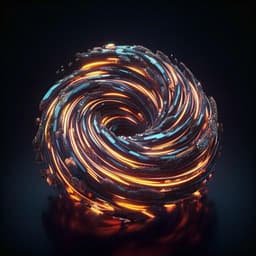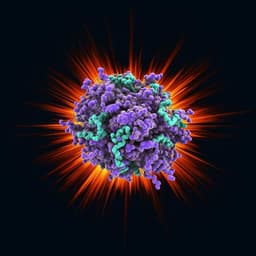
Physics
Ultrafast relaxation of photoexcited superfluid He nanodroplets
M. Mudrich, A. Laforge, et al.
Explore the fast-paced world of helium nanodroplets and their ultrafast relaxation processes, as this research addresses the intricate light-matter interactions within superfluid systems. Conducted by a team of experts, this study uncovers a fascinating three-step relaxation pathway that showcases the power of femtosecond extreme-ultraviolet pulses in revealing nanosystem photodynamics.
Playback language: English
Introduction
Understanding the ultrafast response of condensed-phase nanosystems to photoexcitation is crucial across various research fields, including atmospheric science, radiation damage in biological systems, light-harvesting mechanisms, and photocatalysis. However, the complex interplay between electronic and translational degrees of freedom poses significant theoretical challenges. The heterogeneity of solid or liquid systems and difficulties in sample preparation and measurement reproducibility further complicate the unraveling of elementary relaxation steps. Superfluid helium nanodroplets offer an ideal model system due to their simple electronic structure, extremely weak interatomic binding, and homogeneous, nearly size-independent structure. They enable the study of photodynamics in weakly bound nanostructures, providing insights into the fluid dynamics, dissipation, and transport properties of superfluids at the molecular scale. Previous studies, using theoretical models and static photoexcitation experiments, have inferred a dynamic response to resonant XUV photon absorption involving excitation localization, void cavity (bubble) formation around the excitation, and bubble expansion. Depending on the excitation's proximity to the surface, either the bubble collapses before full formation, ejecting He or He*, or it remains metastable within the droplet. Laser-based high-harmonic light sources have revealed various ultrafast processes initiated by exciting high-lying states, including slow electron emission and ultrafast interband relaxation. However, the dynamics of low-lying states below the autoionization threshold, specifically bubble formation at the strongest absorption band, remained unexplored. This study directly probes the relaxation dynamics of pure He nanodroplets by exciting these lowest excited states using tunable XUV pulses from the seeded free-electron laser (FEL) FERMI.
Literature Review
Prior research on the photoexcitation of helium nanodroplets has primarily focused on understanding the behavior of excited states and their subsequent relaxation. Theoretical and experimental studies suggested a model where the excitation localizes rapidly on an atomic or molecular center. This localization leads to a void, or bubble, formation around the excitation due to Pauli repulsion between the excited electron and surrounding ground-state helium atoms. The bubble's size and fate depend on the location of the excitation within the droplet; it may collapse or remain metastable, potentially leading to the ejection of the excited atom. While prior work provided significant insight, there was a gap in understanding the dynamics of low-lying excited states below the autoionization threshold, particularly the behavior at the strongest absorption bands. The dynamics of these states, and the bubble formation process specifically, were not fully probed.
Methodology
The experiments were conducted at the low-density matter (LDM) end station of the seeded free-electron laser FERMI. Helium nanodroplets were generated by expanding helium gas through a pulsed, cryogenically cooled Even-Lavie nozzle. The droplet size was controlled by adjusting the nozzle temperature. Linearly polarized XUV pulses (21.0–22.2 eV), with a bandwidth <0.1 eV and a duration of ~100 fs FWHM, were generated by the FERMI FEL. These pulses were focused to a 0.5 mm spot size and attenuated to minimize non-linear effects. UV probe pulses (170 fs duration) were generated by frequency-tripling part of the seed laser for the FEL and superimposed with the XUV pulses. The temporal cross-correlation was measured using two-photon ionization of He atoms. Photoelectron spectra (PES) were recorded using a velocity-map imaging (VMI) spectrometer, with electrons imaged onto a position-sensitive detector. Data acquisition involved accumulating images from 2000 shots for each pump-probe delay (50 fs steps). Background subtraction was performed by desynchronizing the He droplet bunches from the FEL pulses. The VMI images were then inverted using the pBasex routine to extract electron kinetic energy and angular distributions. Ab initio calculations of He–He and He⁺–He potentials and the transition dipole moment were conducted at the CC3-EOM and MRCI levels using the Psi4 and Molpro codes, respectively. Time-dependent density functional theory (TD-DFT) calculations simulated the three-dimensional dynamics of He excitation in a 1000-atom He droplet, visualizing the He density distribution over time.
Key Findings
Time-resolved PES revealed a two-component spectral feature upon excitation. A broad feature (D) dominated at short delays (≤0.5 ps), while a sharp peak (A) emerged at longer delays. The peak areas showed an inverse relationship, indicating population transfer from D to A within 0.5–2.5 ps. The energy of peak D decreased rapidly (<1 ps), then slowly, while peak A remained constant after an initial slight shift. The final energy of peak A matched the expected ionization energy of a He atom in the lowest excited singlet state (1s2s ¹S). This finding, consistent across various droplet sizes, led to the association of peak A with the ionization of a surface-bound or ejected 1s2s ¹S-excited He*. Peak D was attributed to He* located deeper within the droplet, experiencing an energetic upshift. The study compared experimental PES with theoretical potential energy curves of the He₂ excimer and found consistency between the observed blue-shifted absorption and the steep upwards bending of the optically active states. TD-DFT calculations showed that the system's evolution differed based on the excitation's initial position relative to the droplet surface. Surface excitations showed local compression and prompt He* desorption, similar to excited alkali metal atoms. Deeper excitations showed bubble formation, followed by bursting at ~4 ps, allowing He* escape. Simulations of time-dependent PES revealed a rapid drop in electron kinetic energy, matching experimental observations. The average of simulated curves closely tracked the experimental curve for feature D, converging to the final value of atomic peak A, with oscillation attributed to bubble oscillation. This comprehensive analysis unveiled a three-step relaxation pathway: 1) ultrafast (<250 fs) interband relaxation to the 1s2s ¹S state; 2) bubble formation (~0.5 ps); and 3) bubble migration to the surface and He* release (~2.5 ps).
Discussion
The observed ultrafast relaxation, despite the superfluid nature and weak binding of He atoms, highlights the efficient coupling of electronic and nanofluid nuclear degrees of freedom. The three-step relaxation pathway is consistent across various droplet sizes, indicating that energy dissipation is very efficient even for the lowest excited states. The combination of experimental time-resolved photoelectron spectroscopy and TD-DFT simulations offers a detailed mechanistic understanding of the process. The findings suggest a general mechanism for weakly bound condensed-phase systems and pave the way for exploring similar dynamics in more complex systems.
Conclusion
This research provides a comprehensive understanding of the ultrafast relaxation dynamics of photoexcited superfluid He nanodroplets. The use of tunable XUV pulses enabled detailed observation of a three-step relaxation process. Future studies could utilize more advanced light sources to achieve atomic-resolution imaging of the bubble dynamics. The methodology developed could be applied to more complex nanosystems, expanding our knowledge of photodynamics in various excitation regimes.
Limitations
The TD-DFT calculations utilized a simplified model of the nanodroplet, neglecting complexities such as surface roughness and collective excitations. The initial position of the excitation in the simulations was a parameter and the distribution of initial positions was estimated. The accuracy of the simulations depends on the accuracy of the potentials used.
Related Publications
Explore these studies to deepen your understanding of the subject.







